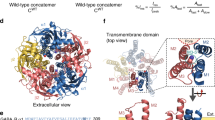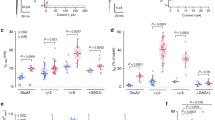Abstract
Determination of the activation mechanism of neurotransmitter-operated ion channels has been hindered by a limited understanding of the relationship between agonist binding and the gating of the integral ion pore. Here we describe a [3H]ligand binding assay that enables us to make repeated binding measurements from the same intact oocyte expressing recombinant human ρ1 GABAC receptors and directly correlate the binding kinetics with electrophysiological measurements. We have determined an association rate for GABA of about 105 M–1s–1; this is four orders of magnitude slower than diffusion, indicating GABA has restricted access to its binding site. We also demonstrate that GABA dissociates at two rates. Our data are consistent with the faster rate being the true microscopic dissociation rate of GABA, with the slower rate occurring because the opening of the pore detains agonist release.
This is a preview of subscription content, access via your institution
Access options
Subscribe to this journal
Receive 12 print issues and online access
$209.00 per year
only $17.42 per issue
Buy this article
- Purchase on Springer Link
- Instant access to full article PDF
Prices may be subject to local taxes which are calculated during checkout






Similar content being viewed by others
References
Auerbach, A. A statistical analysis of acetylcholine receptor activation in Xenopus myocytes: stepwise versus concerted models of gating. J. Physiol. (Lond.) 461, 339–378 ( 1993).
Colquhoun, D. & Sakmann, B. Fast events in single-channel currents activated by acetylcholine and its analogues at the frog muscle end-plate. J. Physiol. (Lond.) 369, 501– 557 (1985).
Colquhoun, D. & Ogden, D. C. Activation of ion channels in the frog end-plate by high concentrations of acetylcholine. J. Physiol. (Lond.) 395, 131–159 ( 1988).
Sine, S. M. & Steinbach, J. H. Activation of acetylcholine receptors on clonal mammalian BC3H-1 cells by high concentrations of agonist. J. Physiol. (Lond.) 385, 325– 359 (1987).
Weiss, D. S. & Magleby, K. L. Gating scheme for single GABA-activated Cl– channels determined from stability plots, dwell-time distributions, and adjacent-interval durations. J. Neurosci. 9, 1314–1324 (1989).
Twyman, R. E., Rogers, C. J. & Macdonald, R. L. Intraburst kinetic properties of the GABAa receptor main conductance state of mouse spinal cord neurones in culture. J. Physiol. (Lond.) 423, 193– 220 (1990).
Colquhoun, D. Imprecision in presentation of binding studies. Trends Pharmacol. Sci. 6, 197 (1985).
Colquhoun, D. Binding, gating, affinity and efficacy. The interpretation of structure-activity relationships for agonists and of the effects of mutating receptors. Br. J. Pharmacol. 125, 923–948 (1998).
Colquhoun, D. & Sakmann, B. From muscle endplate to brain synapses: a short history of synapses and agonist-activated ion channels. Neuron 20, 381–387 ( 1998).
Katz, B. & Miledi, R. The binding of acetylcholine to receptors and its removal from the synaptic cleft. J. Physiol. (Lond.) 231, 549–574 (1973).
Colquhoun, D., Dionne, V. E., Steinbach, J. H. & Stevens, C. F. Conductance of channels opened by acetylcholine-like drugs in muscle endplate. Nature 253, 204–206 (1975).
Sheridan, R. E. & Lester, H. A. Relaxation measurements on the acetylcholine receptor. Proc. Natl. Acad. Sci. USA 72, 3496–3500 (1975).
Sheridan, R. E. & Lester, H. A. Functional stoichiometry at the nicotininc receptor: The photon cross section for phase 1 corresponds to two bis-q molecules per channel. J. Gen. Physiol. 80, 499–515 (1982).
Amin, J. & Weiss, D. S. Homomeric ρ1 GABA channels: activation properties and domains. Receptors Channels 2, 227–236 (1994).
Shimada, S., Cutting, G. & Uhl, G. R. γ-aminobutyric acid a or c receptor? γ-aminobutyric acid ρ1 receptor RNA induces bicuculline-, barbiturate-, and benzodiazepine-insensitive γ-aminobutyric acid responses in Xenopus oocytes. Mol. Pharmacol. 41, 683–687 (1992).
Enna, S. J. & Snyder, S. H. Properties of γ-aminobutyric acid (GABA) binding in rat brain synaptic membrane fractions. Brain Res. 100, 81–97 ( 1975).
Neubig, R. R. & Cohen, J. B. Permeability control by cholinergic receptors in Torpedo postsynaptic membranes: agonist dose-response relations measured at second and millisecond times. Biochemistry 19, 2770–2779 ( 1980).
Olsen, R. W. Drug interactions at the GABA receptor-ionophore complex. Annu. Rev. Pharmacol. Toxicol. 22, 245–277 (1982).
Chang, Y. & Weiss, D. S. Substitutions of the highly conserved M2 leucine create spontaneously opening ρ1 γ-aminobutyric acid receptors. Mol. Pharmacol. 53, 511– 523 (1998).
Amin, J. & Weiss, D. S. Insights into the activation of ρ1 GABA receptors obtained by coexpression of wild type and activation-impaired subunits. Proc. R. Soc. Lond. B 263, 273 –282 (1996).
Maconochie, D., Zempel, J. & Steinbach, J. How quickly can GABAA receptors open? Neuron 12, 61–71 ( 1994).
Lavoie, A. M., Tingey, J. J., Harrison, N. L., Pritchett, D. B. & Twyman, R. E. Activation and deactivation rates of recombinant GABAA receptor channels are dependent on α-subunit isoform. Biophys. J. 73, 2518–2526 (1997).
Tia, S., Wang, J. F., Kotchabhakdi, N. & Vicini, S. Distinct deactivation and desensitization kinetics of recombinant GABA A receptors. Neuropharmacology 35, 1375–1382 (1996).
Rang, H. P. The kinetics of action of acetylcholine antagonists in smooth muscle. Proc. R. Soc. Lond. B 164, 488–510 (1966).
Thron, C. D. & Waud, D. R. The rate of action of atropine. J. Pharmacol. Exp. Ther. 160, 91– 105 (1968).
Colquhoun, D., Large, W. A. & Rang, H. P. An analysis of the action of a false transmitter at the neuromuscular junction. J. Physiol. (Lond.) 266, 361–395 (1977).
Armstrong, D. L. & Lester, H. A. The kinetics of tubocurarine action and restricted diffusion within the synaptic cleft. J. Physiol. (Lond.) 294, 365– 386 (1979).
Unwin, N. Acetylcholine receptor channel imaged in the open state. Nature 373, 37–43 ( 1995).
Monod, J., Wyman, J. & Changeux, J. P. On the nature of allosteric proteins: a plausible model. J. Mol. Biol. 12, 88– 118 (1965).
Haber, J. E. & Koshland, D. E. Relation of protein subunit interactions to the molecular species observed during cooperative binding of ligands. Proc. Natl. Acad. Sci. USA 58, 2087–2093 (1967).
Liman, E. R., Tytgat, J. & Hess, P. Subunit stoichiometry of a mammalian K+ channel determined by construction of multimeric cDNAs. Neuron 9, 861–871 ( 1992).
Chang, Y., Wang, R., Barot, S. & Weiss, D. S. Stoichiometry of a recombinant GABAA receptor. J. Neurosci. 16, 5415–5424 (1996).
Colquhoun, D. & Hawkes, A. G. On the stochastic properties of single ion channels. Proc. R. Soc. Lond. B 211, 205–235 (1981).
Bean, B. P. ATP-activated channels in rat and bullfrog sensory neurons: concentration dependence and kinetics. J. Neurosci. 10, 1–10 (1990).
Acknowledgements
We thank Robin A.J. Lester and Michael Quick for discussion. This work was supported by grants from the NIH (NS35291 and NS36196) and W.M. Keck Foundation (931360).
Author information
Authors and Affiliations
Corresponding author
Rights and permissions
About this article
Cite this article
Chang, Y., Weiss, D. Channel opening locks agonist onto the GABAC receptor. Nat Neurosci 2, 219–225 (1999). https://doi.org/10.1038/6313
Received:
Accepted:
Issue Date:
DOI: https://doi.org/10.1038/6313
This article is cited by
-
Electrophysiology of ionotropic GABA receptors
Cellular and Molecular Life Sciences (2021)
-
Evidence for an effect of receptor density on ligand occupancy and agonist EC50
Scientific Reports (2019)
-
Orthosteric- versus allosteric-dependent activation of the GABAA receptor requires numerically distinct subunit level rearrangements
Scientific Reports (2017)
-
Competitive antagonists facilitate the recovery from desensitization of α1β2γ2 GABAA receptors expressed in Xenopus oocytes
Acta Pharmacologica Sinica (2016)
-
A Hydrophobic Area of the GABA ρ1 Receptor Containing Phenylalanine 124 Influences Both Receptor Activation and Deactivation
Journal of Molecular Neuroscience (2015)



